

News & Press. 4 November 2014 Cosyflex underwear and fabric samples are exhibited in the 3D: Printing the Future exhibition at the Manchester Museum of Science and Industry. 30 October 2014 Tamicare have signed an agreement with Kronosept AB to produce our specially designed pads.
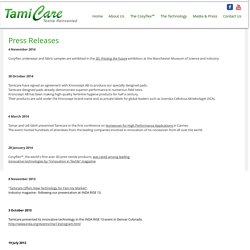
Tamicare designed pads already demonstrate superior performance in numerous field tests. Kronosept AB has been making high-quality feminine hygiene products for half a century. Their products are sold under the Kronosept brand name and as private labels for global leaders such as Svenska Cellulosa Aktiebolaget (SCA). 6 March 2014. New: 3D Print Your Own Ski Boot Insoles. If you are a skier, you will probably know about the long process of getting fitted for a new pair of ski boots.
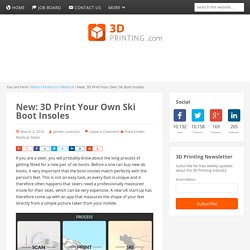
Before a one can buy new ski boots, it very important that the boot insoles match perfectly with the person’s feet. This is not an easy task, as every foot is unique and it therefore often happens that skiers need a professionally measured insole for their skies, which can be very expensive. A new UK start-up has therefore come up with an app that measures the shape of your feet directly from a simple picture taken from your mobile. It’s definitely an invention in the category ‘what will they think of next’, but ALPrint, the start-up we’re talking about, really claims only a couple of mobile camera pictures are required for them to be able to do the job. The ‘patient’ only needs to print out an easily printable calibration mat, and to stand on this mat whilst taking pictures. Another company is Australian based team 3D Orthotics. ONLINE COURSES — Francis Bitonti Studio. IMPRESSION 3D. 3DFab - Toute l'actualité de l'impression 3D. 3DP Applications.
Le brevetage d'ovules autorisé s'ils ne peuvent pas devenir des êtres humains. 5 raisons gourmandes de changer d’avis sur les OGM. BU Research Blog. Following the internal launch at BU on the 14th February 2014, BU Researchers at the Centre for Intellectual Property Policy and Management (CIPPM) launched the Copyrightuser.org at The Arts and Humanities Research Council (AHRC) Creative Economy Showcase.
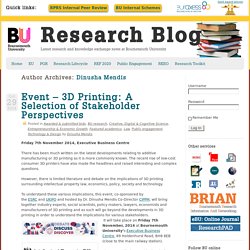
The event was held at Kings Place, London, on Wednesday 12th March 2014. The Showcase demonstrated the outputs and innovations of AHRC investments in the Creative Economy through presentations, workshops and exhibitions. The sectors exhibited on the day, included fashion, design, video games, architecture, broadcasting, archives, digital technologies and dance.
Amongst the various funded initiatives showcased on the day, Copyrightuser.org held a prominent exhibition stand and exhibited the website which was complemented by large posters, bookmarks and myth/reality cards (illustrated below) which explained the most common myths about copyright. Highlights from the day can be streamed here. The copyrightuser.org team consists of: Ghosts created by scientists in 'disturbing' lab experiment. Volunteers took part in an experiment which mixed up their movements and brain signals.

They saw up to four phantoms positioned around them and believed that ghosts were touching their backs with invisible fingers. Professor Olaf Blanke, from the Ecole Polytechnique Federale de Lausanne (EPFL) in Switzerland, said: "Our experiment induced the sensation of a foreign presence in the laboratory for the first time. “It shows that it can arise under normal conditions, simply through conflicting sensory-motor signals. "This confirms that it is caused by an altered perception of their own bodies in the brain. " To manifest their ghosts, the scientists set up a robot device that allowed volunteers to control the movements of a jointed mechanical arm with their index fingers. The movements were relayed to another robot arm behind them which touched their backs.
That felt weird enough to the blindfolded participants. Accompanied by his brother, he was freezing, exhausted and oxygen-starved. 3D Printed Materials and the Circular Economy - Think Dif - Disruptive Innovation Festival. 22 Oct 10:00 BST - 22 Oct 10:30 BST You'll need to sign up for the Disruptive Innovation Festival to attend this event This session does not have a live or video element, rather, it is an article written especially for the Disruptive Innovation Festival.

Have a read and discuss in the cafe area. The Author Alysia Garmulewicz Saïd Business School, University of Oxford Alysia.garmulewicz@sbs.ox.ac.uk. Les incroyables promesses de l’impression 3D - Innovation produits. En quelques trimestres, l’imprimante 3D, née dans les années 1980, est passée du statut de curiosité à celui de machine utile dans le monde professionnel, y compris dans la construction.
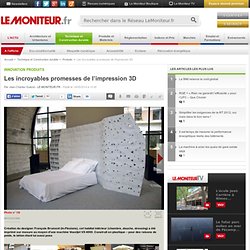
Revue des possibilités. Imprimer une… maison. Gutenberg en perdrait son latin. L’imprimante 3D de chantier va-t-elle bientôt remplacer les entreprises de BTP ? - Projets. Architectes et ingénieurs s’activent pour être les premiers à imprimer intégralement un bâtiment.
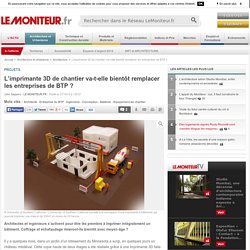
Coffrage et échafaudage rimeront-ils bientôt avec moyen-âge ? Il y a quelques mois, dans un jardin d’un lotissement du Minnesota a surgi, en quelques jours un château médiéval. MIT lab develops programmable shape-shifting carbon fibre. MIT's Self-Assembly Lab has developed materials that can be programmed to transform their shape autonomously -- from flexible carbon fibre and hybrid plastics to wood grains and textiles.
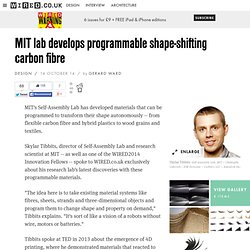
Skylar Tibbits, director of Self-Assembly Lab and research scientist at MIT -- as well as one of the WIRED2014 Innovation Fellows -- spoke to WIRED.co.uk exclusively about his research lab's latest discoveries with these programmable materials. "The idea here is to take existing material systems like fibres, sheets, strands and three-dimensional objects and program them to change shape and property on demand," Tibbits explains. "It's sort of like a vision of a robots without wire, motors or batteries. " Tibbits spoke at TED in 2013 about the emergence of 4D printing, where he demonstrated materials that reacted to passive energy sources like water, folding twisting to a programmed shape.
"We released it at TED the response totally blew us away," Tibbits says. Top Predictions 2014: Plan for a Disruptive, but Constructive Future. Already have a Gartner account?
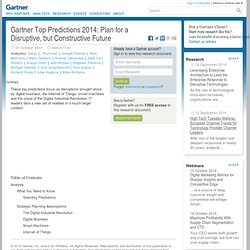
Sign in to view this research document. Forgot username or password? Vidéo > Strati : la première voiture imprimée en 3D. S'interroger sur l'expertise neurobiologique. UP Magazine. Livrecardon.pdf. UP' Magazine. UP' Magazine. L'amélioration de la qualité de la vie quotidienne constitue depuis toujours une des préoccupations majeures de l'homme.
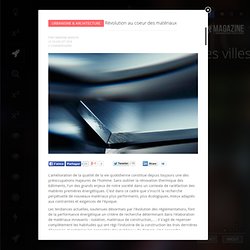
Sans oublier la rénovation thermique des bâtiments, l'un des grands enjeux de notre société dans un contexte de raréfaction des matières premières énergétiques. C'est dans ce cadre que s'inscrit la recherche perpétuelle de nouveaux matériaux plus performants, plus écologiques, mieux adaptés aux contraintes et exigences de l'époque. Les tendances actuelles, soutenues désormais par l'évolution des réglementations, font de la performance énergétique un critère de recherche déterminant dans l'élaboration de matériaux innovants : isolation, matériaux de construction,... ; il s'agit de repenser complètement les habitudes qui ont régi l'industrie de la construction les trois dernières décennies et optimiser les propriétés des matériaux de demain.
UP' Magazine. Juva Santé fabricant du célébrissime Mercurochrome et spécialiste des produits paramédicaux commercialisera à partir du 12 novembre prochain deux bracelets connectés : le Coach Forme et Sommeil et le Coach Stress. Le premier permettra aux utilisateurs de surveiller leur forme et la qualité de leur sommeil, à l'image du Pulse de Withings, tandis que le second leur permettra de mesurer et de mieux gérer le niveau de stress en mesurant le rythme cardiaque grâce à une application mobile dédiée. Objet connecté oblige, c’est via une application sur smartphone que l'on pourra décoder et analyser les données collectées. L’application proposera tout un tas de conseils ou d’exercices à faire afin d’améliorer sa santé. Les produits seront vendus moins de 40 € pour être accessibles à toute la famille. Une marque historique innovante. Modern Meadow. Le blog de Yannick Rumpala. Suite des réflexions annoncées dans le billet précédent sur les imprimantes 3D. Je me permets ici de détourner et d’adapter le titre du deuxième chapitre du livre d’Elizabeth L.
Eisenstein (The Printing Press As an Agent of Change, Cambridge, Cambridge University Press, 1979, dont on peut également trouver une version en français).